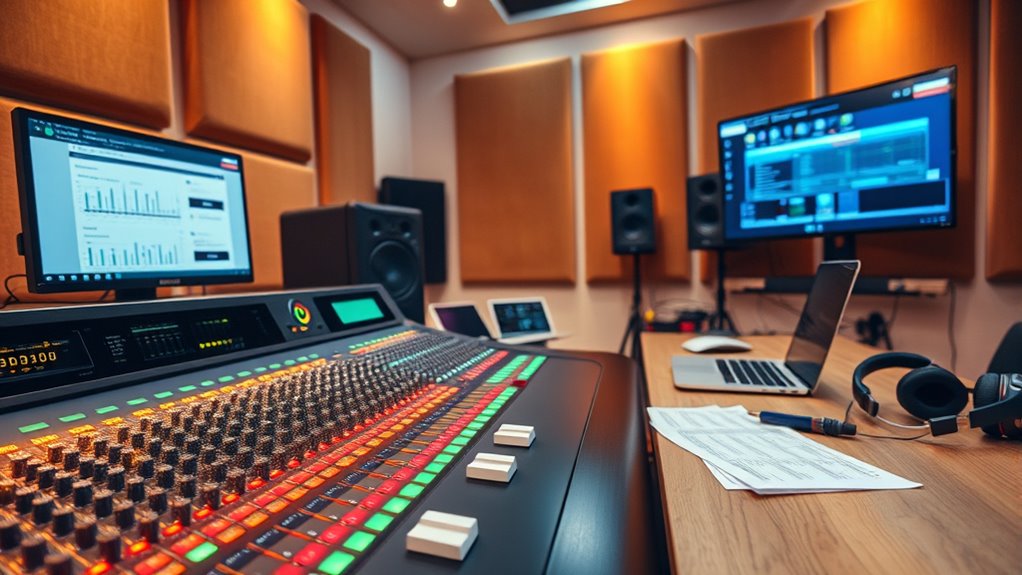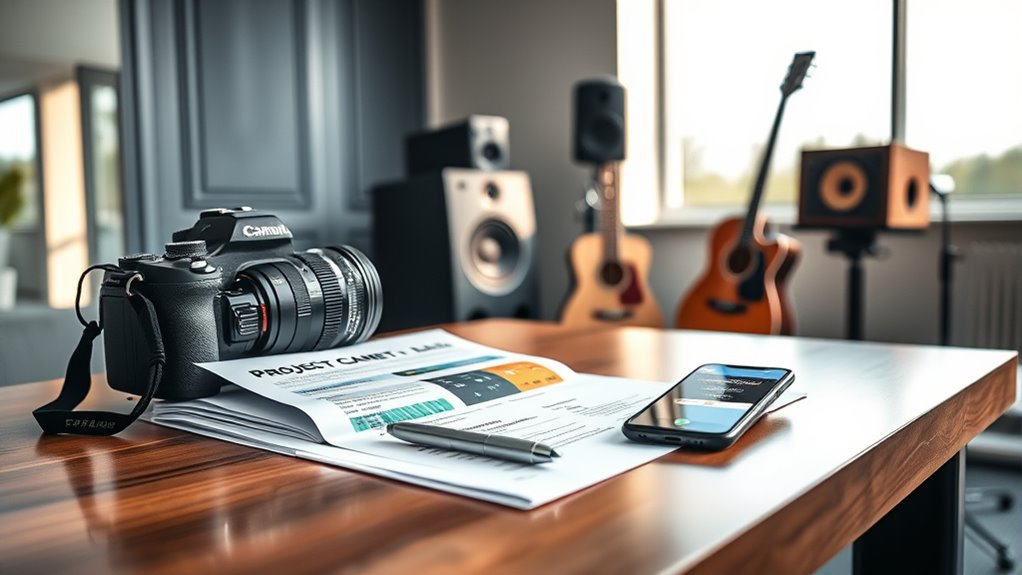To write a clear project brief for music clients, start by defining your goals, target audience, and artistic style. Include details about licensing needs, promotional strategies, and key milestones with deadlines and budgets. Clarify everyone’s roles and provide references or visuals to illustrate your vision. A well-structured brief keeps everyone aligned, minimizes misunderstandings, and guarantees smooth progress. Keep these tips in mind for an all-encompassing plan—you’ll find more insights as you explore further.
Key Takeaways
- Clearly define the project scope, including type (single, EP, album), style, mood, and target audience.
- Specify licensing requirements for synchronization, performance, or commercial use to ensure legal compliance.
- Outline promotional strategies such as social media, live shows, and collaborations to maximize reach.
- Set specific goals, milestones, deadlines, and budget constraints to keep the project on track.
- Clarify team roles, reference materials, and visual inspirations to align expectations and streamline collaboration.

Creating a clear project brief is essential for ensuring your music project runs smoothly and meets your expectations. When you start with a well-defined plan, it helps you communicate your vision effectively, streamlines decision-making, and keeps everyone on the same page. One of the key aspects to focus on early in your brief is music licensing. Clarify whether your project will require licensing for commercial use, synchronization rights, or performance rights. Knowing this upfront saves you from legal complications later and enables you to budget appropriately. Including details about how you plan to handle licensing ensures your team understands the legal boundaries and avoids potential delays or disputes.
A clear project brief clarifies licensing needs, preventing legal issues and ensuring smooth project execution.
Beyond licensing, your project brief should also outline your promotional strategies. Think about how you’ll promote your music, whether through social media, live performances, collaborations, or digital marketing campaigns. Clearly defining your promotional approach helps guide your creative decisions and ensures your team is aligned on the target audience and messaging. When you specify your promotional strategies early on, you can also plan around the timing of releases, coordinate marketing efforts, and allocate resources efficiently. This proactive approach maximizes your music’s reach and impact.
To make your project brief truly effective, be specific about your goals and deliverables. For example, state whether you’re aiming for a single, an EP, or a full album, and set clear milestones for each stage of production. Include details about the style, mood, and target audience for your music, so everyone involved understands the artistic vision. Additionally, outline your budget constraints and deadlines. This transparency helps avoid misunderstandings and ensures your project stays on track financially and schedule-wise. When planning your project, keep in mind that the quality of your final product can be greatly influenced by color accuracy, which impacts the visual presentation of your music videos or promotional materials.
Don’t forget to specify the roles and responsibilities of each team member. Clarify who handles licensing negotiations, who manages promotional outreach, and who oversees production. When everyone knows their responsibilities, it minimizes confusion and promotes a more efficient workflow. Including references or examples of preferred styles, references to similar projects, or inspiration can further clarify your vision. The more precise your brief, the easier it is to execute your project seamlessly from start to finish.
Frequently Asked Questions
How Detailed Should My Music Project Budget Be?
You should make your music project budget detailed enough for effective budget planning and expense tracking. Include all major costs like studio time, mixing, mastering, and marketing. Break down expenses into categories to stay organized and identify potential overspending early. The more precise your budget, the better you’ll manage resources and ensure your project stays on track financially. Keep it clear and adaptable as your project develops.
What File Formats Are Preferred for Music Delivery?
Did you know that WAV files remain the most preferred for music delivery, with over 60% of professionals choosing them? For your project, stick to high-quality music file formats like WAV or AIFF to guarantee the best sound. Always check the delivery specifications provided by your client, including preferred file formats and compression settings, to secure smooth transfer and ideal playback quality across all devices.
How Do I Handle Copyright and Licensing Concerns?
You should prioritize understanding music rights and licensing agreements early on. Make sure you have written permissions from rights holders, clearly specifying how the music will be used. Always confirm that licensing covers all intended uses, such as broadcast or digital distribution. To avoid legal issues, document everything, and consider consulting a legal expert to review your rights and licensing terms, ensuring your project stays compliant and protected.
What Is the Typical Timeline for Project Completion?
You can typically expect a project to take 4 to 8 weeks, depending on the music genre and collaboration methods. For faster completion, establish clear milestones and regular check-ins. If you’re working on a pop track, it might be quicker, while orchestral pieces could take longer. Communicate your timeline upfront, and be flexible to accommodate creative processes and licensing needs, ensuring everyone stays aligned throughout the project.
How Can I Ensure My Vision Is Accurately Communicated?
Think of your artistic vision as a melody that needs to be heard clearly. To guarantee it’s accurately communicated, articulate your creative goals with vivid detail, using descriptive language that paints a picture. Share reference tracks, sketches, or mood boards to harmonize your ideas. Keep open communication, listen actively, and confirm understanding at each step, so your vision resonates perfectly through every note and detail.
Conclusion
A clear project brief guarantees everyone’s on the same page, saving time and avoiding misunderstandings. By defining your goals, target audience, style, and deadlines upfront, you set a solid foundation for your music project. Remember, 70% of successful projects start with a well-crafted brief. This simple step can make all the difference, helping you achieve the sound you envision while keeping your team aligned and motivated from start to finish.










